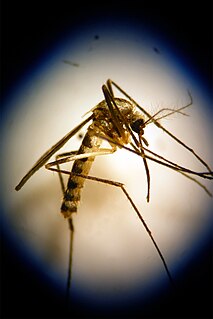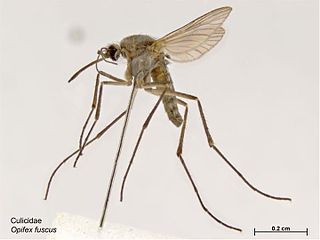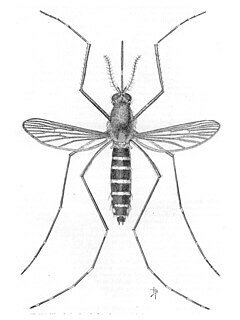
A mosquito is any member of a group of about 3,500 species of small insects belonging to the order Diptera (flies). Within Diptera, mosquitoes constitute the family Culicidae. The word "mosquito" is Spanish and Portuguese for "little fly". Mosquitoes have a slender segmented body, one pair of wings, one pair of halteres, three pairs of long hair-like legs, and elongated mouthparts.

Aedes albopictus, from the mosquito (Culicidae) family, also known as (Asian) tiger mosquito or forest mosquito, is a mosquito native to the tropical and subtropical areas of Southeast Asia. In the past few decades, however, this species has spread to many countries through the transport of goods and international travel. It is characterized by the white bands on its legs and body.
La Crosse encephalitis is an encephalitis caused by an arbovirus which has a mosquito vector.

Aedes aegypti, the yellow fever mosquito, is a mosquito that can spread dengue fever, chikungunya, Zika fever, Mayaro and yellow fever viruses, and other disease agents. The mosquito can be recognized by white markings on its legs and a marking in the form of a lyre on the upper surface of its thorax. This mosquito originated in Africa, but is now found in tropical, subtropical and temperate regions throughout the world.

The Culicinae are the most extensive subfamily of mosquitoes (Culicidae) and have species in every continent except Antarctica, but are highly concentrated in tropical areas. Mosquitoes are best known as parasites to many vertebrate animals and vectors for disease. They are holometabolous insects, and most species lay their eggs in stagnant water, to benefit their aquatic larval stage.

Aedes vexans, the inland floodwater mosquito or tomguito, is a cosmopolitan and common pest mosquito.
Psorophora howardii is a species of mosquito. The species was described by the American entomologist Daniel William Coquillett in 1901.

Ochlerotatus triseriatus, also known by the synonym Aedes triseriatus, is a member of the true fly order. It is called the eastern tree hole mosquito due to its predilection towards breeding in stagnant water that is found in natural holding containers such as tree holes. It is native to the eastern United States and southern Canada and favors hardwood habitats. It has been found as far south as the Florida Keys, as far west as Idaho and Utah, and as far north as Quebec and Ontario. This species has not yet been found in Europe, but it has the potential to spread through international trade. In 2004, it was found in a shipment of tires travelling from Louisiana to France, but it was identified and targeted with insecticides that truncated its spread. It is a known vector of La Crosse encephalitis and canine heartworm disease. In the laboratory, it has been found to vector several other viruses including yellow fever, eastern encephalitis, Venezuelan encephalitis, and western encephalitis. Because of its potential for international spread and its proclivity for transmitting disease, monitoring the distribution of this species is essential.
Ochlerotatus sticticus is an uncommon mosquito, although the species can be abundant along river floodlands. It has been known to be responsible for human bites. Like all mosquitoes, it is only the females that bite.

Aedes sollicitans, the eastern saltmarsh mosquito, is a species of mosquito native to the eastern seaboard of the United States and Canada as well as the entire Gulf coast and is also present in the Bahamas and Greater Antilles. While primarily found in coastal areas within a few miles of the coast, it is occasionally found inland in areas with saline pools, the species was reported as far west as Arizona. The species is a prime vector for Eastern equine encephalitis, Venezuelan equine encephalitis and dog heartworm.

Aedes canadensis, the woodland pool mosquito, is an aggressive, day biting mosquito that can be a vector of a number of diseases which is found mainly in eastern North America.
Dirofilaria tenuis is a species of nematode, a parasitic roundworm that infects the subcutaneous tissue of vertebrates. D. tenuis most commonly infects raccoons, but some human cases have been reported. They are vectored by mosquitoes and follow similar development and transmission patterns as other Dirofilaria.
Aedes australis is a brackish water mosquito species from the genus Aedes subgenus Halaedes. This was first confronted in New Zealand in 1961.
Aedes mitchellae mosquitoes were originally collected in southern Georgia and Florida in 1905 by entomologist Harrison Gray Dyar, Jr. The species' range extends through the coastal plains from the southeastern United States, north to New York and west to New Mexico with the greatest abundance in the Atlantic and Gulf coastal plains.
Aedes vittatus is a species of mosquito that was first described in 1861 as Culex vittatus from specimens collected on Corsica. In 2000, the species was transferred to the newly erected subgenus Fredwardsius as the type species representing the subgenus.

Aedes japonicus, commonly known as the Asian bush mosquito or the Asian rock pool mosquito, was first described by Theobald in 1901 from Tokyo, Japan and has four known subspecies Ae. j. japonicus, Ae. j. shintienensis, Ae. j. yaeyamensis, and Ae. j. amamiensus. They are competent arbovirus vectors known to transmit the West Nile virus as well as Japanese and St. Louis encephalitis. They are listed as an invasive species by the Global Invasive Species Database.

Tetragnatha montana, commonly known as the silver stretch spider, is a species of long-jawed orb weaver from the family Tetragnathidae that has a Palearctic distribution. It preys mostly on flies and mosquitoes. The name silver stretch spider refers to its shiny metallic colour and its habit of extending its legs into a stick like shape.

Opifex fuscus, known commonly as the saltpool mosquito or by its Māori name naeroa, is an endemic mosquito that is widespread along the coast of New Zealand.

Aedes taeniorhynchus, or the black salt marsh mosquito, is a mosquito in the family Culicidae. It is a carrier for encephalitic viruses including Venezuelan equine encephalitis and can transmit Dirofilaria immitis. It resides in the Americas and is known to bite mammals, reptiles, and birds. Like other mosquitoes, Ae. taeniorhynchus adults survive on a combination diet of blood and sugar, with females generally requiring a blood meal before laying eggs.












